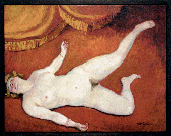- Dates
- —
In past centuries, resemblance was the main focus in painting, just as it was for the human body that was studied and dissected in fine arts academies through beautiful, reassuring images. A new feeling emerged in the twentieth century; a new way of being, of living, of thinking. Of course the academic world was always in the background and from time to time came to the forefront. But artists had found a new freedom, and each one learned to be their own master.
What is there in common in the works of Derain, Matisse, Picasso, Bacon, Giacometti, Chagall, Miró, Freud, Magritte, De Staël, Klein and Tàpies? Nothing other than the liberty to express what they feel instead of what they see. They argue strongly for the possibility of making the human body appear out of the enigmas of life.
Thus, in the painting but also all in the sculpture of the twentieth century, in the work of many artists the body is marked by ceaseless inspiration and by contradictions that have opened up firm, unsuspected, generous new paths. These artists show ways of expressing themselves that can be described, if not as confessions, at least as true confidences. From now on, the body can be exhibited without inhibitions or complexes, unmasked by any drapery. Aware of having recovered the absolute possibility of expressing the body, artists can translate its grandeur and also its extreme, painful fragility. They weave new presences, from both a physical and a metaphysical distance. The body has rediscovered the meaning of its origins. It can henceforth be revealed without surprises, without hindrance and without mystery; simply for the extreme pleasure of looking at it, finally, in all its beautiful, disturbing, unexpected truth. A body without limits.
J.-L. Prat



